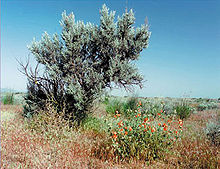Shrub steppe
Shrub steppes form a type of landscape within the grasslands that is formed when there is little rainfall. Although the conditions can be considered arid , there is enough moisture available in the shrub steppes to be able to develop a permanent plant cover from grasses and / or bushes, which distinguishes them from deserts .
The primary ecological processes that worked in the past to form shrub steppes are drought and fire . The plant species of the shrub steppes have developed special adaptations for the low annual rainfall and summer drought. Their adaptation to the landscape and their distribution in it depends on the soil moisture . Occasional fires, which leave a patchwork pattern of shrubs and grasses in the vegetation cover, characterize the shrub steppes as a type of landscape or ecosystem.
North America


The shrub steppes of North America occur in the western United States and in western Canada in the rain shadow area between the Cascade Range and the Sierra Nevada in the west and the Rocky Mountains in the east. They extend south from south-central British Columbia to southeast Washington , eastern Oregon and eastern California and across Idaho , Nevada and Utah to western Wyoming and Colorado , as well as northern and central New Mexico and northern Arizona . The vegetation is dominated by primarily low shrubs such as sagebrush ( Artemisia tridentata ) and Purshia tridentata . The low rainfall actually does not allow trees to grow, but these do occur occasionally. Other important plant species are tussock (here: Pseudoroegneria spicata ), which was imported as fodder for cattle in historical times, but quickly from non-indigenous annual plants such as roof broth ( Bromus tectorum , English cheatgrass ), Hungarian rocket ( Sisymbrium altissimum , English tumble mustard ) and Kali saltwort ( Kali turgidum , English Russian thistle ) was displaced. The shrub steppes are home to a number of animal species, including mugwort , dwarf rabbit , Pacific rattlesnake, and pronghorn .
Historically, a large part of the shrubbery steppes in the US state of Washington was referred to as "scablands" ( German wasteland , see also Channeled Scablands ), a name that, due to the devastating Missoula floods rushing over the area more than 10,000 years ago , the deep channels in dug the upcoming basalt, was awarded. The main sources of threat include overgrazing , landscape fires, the spread of invasive species , agricultural development (as much of the landscape is at lower altitudes and has been converted into fields), and energy development. Only 50% of the originally existing steppes of shrubbery have survived in Washington, and according to other sources only 12 to 15%.
The following ecoregions are distinguished in North America:
- the Great Basin shrub steppe in eastern California, central Nevada, western Utah, and southeast Idaho
- the Snake Columbia shrub steppe in south-central Washington, eastern Oregon, northeast California, northern Nevada, and Idaho
- the Wyoming Basin shrub steppe in central Wyoming, south-central Montana, northeast Utah, southwest Idaho, and northwest Colorado
- the Okanagan shrub steppe in the Okanagan Valley in south-central British Columbia and in the southern Similkameen Valley , which stretches from British Columbia to north-central Washington
See also
Web links
- What about shrub steppe? Background information . Pacific Northwest National Laboratory, last update: October 2017.
- Deserts and xeric shrublands. Terrestrial Ecoregions WWF World Wildlife Fund.
- Deserts and xeric shrublands. ecology Pocket Guide
Individual evidence
- ↑ Shrub-Steppe Ecosystem . In: Ecosystems . Washington Native Plant Society. Retrieved August 14, 2019.
- ↑ Frederick C. Dobler, Jim Eby, Chuck Perry, Scott Richardson, Matthew Vander Haegen: Status of Washington \ 's Shrub-Steppe Ecosystem: Extent, ownership, and wildlife / vegetation relationships . Washington Department of Fish and Wildlife. Retrieved August 14, 2019.
- ↑ Shrub Steppes . Washington Native Plant Society. Retrieved August 14, 2019.
- ↑ Great Basin shrub steppe . WWF . Retrieved August 14, 2019.
- ↑ Snake-Columbia shrub steppe . WWF. Retrieved August 14, 2019.
- ↑ Wyoming Basin shrub steppe . WWF. Retrieved August 14, 2019.
